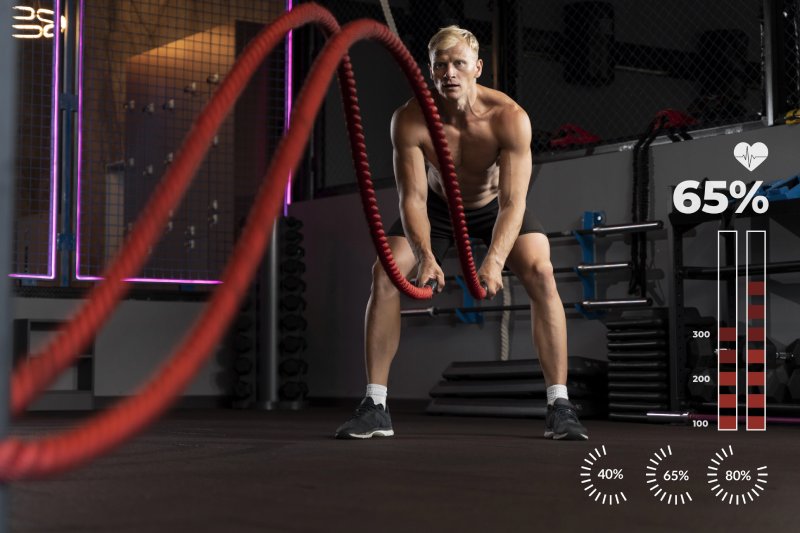Superset strength training is based on the principle of performing two different exercises back to back without rest and is very effective in terms of saving time. While working with this method, one muscle group is worked, and then the second exercise targeting an opposite or complementary muscle group is performed. In this way, both the duration of the workout is shortened and its intensity is increased, which supports more calorie burning and muscle development.
Superset training helps develop muscle endurance and strength at the same time. In particular, since it challenges the muscles more, more micro-tears occur in the muscle fibers, which accelerates muscle growth. At the same time, working with short rest periods increases the heart rate and strengthens the cardiovascular system. This offers advantages for both muscle and heart health.
This training method also improves mental focus and discipline. Having short periods between exercises requires the athlete to concentrate and be more conscious in movement transitions.
It also increases motivation for sports by reducing monotony with constantly changing movements. It is an effective method for overcoming muscle plateau, especially for intermediate and advanced level athletes.

Major Benefits of Superset Strength Training
Superset strength training is based on the principle of performing two different exercises back to back without rest and is a very effective method for both advanced and intermediate athletes. This training technique is ideal for those who want to save time. While the training time is shortened, the level of loading on the muscles increases, increasing efficiency. In this way, a more intense workout is performed in a short time.
This type of training promotes muscle hypertrophy. Instead of constantly working one muscle group, working opposing muscle groups in succession (e.g. biceps-triceps) allows the muscles to recover while working efficiently at the same time. This creates more stress on the muscle fibers, resulting in faster muscle growth. In addition, this high-intensity training method significantly speeds up the metabolism.
Superset workouts also have a positive effect on the cardiovascular system. Since the rest period between exercises is minimal, the heart rate increases, which both increases fat burning and supports cardiovascular health. Therefore, not only strength but also endurance and conditioning are gained. In this respect, it contributes not only to muscle development but also to general health.
Superset training is also very beneficial mentally. The intense tempo makes it harder to get distracted during training and improves focus skills. Since the time between each superset is limited, the athlete must be constantly alert and ready. This develops mental endurance, increases motivation and ensures continuity in training.
Another important benefit is that it reduces muscle imbalance. Since opposing muscle groups are usually worked together in superset training, such as chest-back or quadriceps-hamstring, muscle groups develop in a balanced way. In this way, posture disorders can be prevented and the risk of injury is reduced. The body reaches a more symmetrical and functional form.
The superset method makes workouts more fun and dynamic. For those who are bored with monotonous exercise programs, supersets provide tempo and variety, keeping motivation high. Since it is possible to constantly create new programs with different combinations, both the body and the mind respond positively to these changes. For all these reasons, superset strength training stands out as an efficient, intense and effective training method.

Superset Types and Applications
Superset training is based on the principle of performing exercises that work different muscle groups one after the other without rest. However, there are different types of superset applications within this approach. Each serves different training purposes and adds variety to the training program. Choosing the right type is important for both performance development and efficiency.
- Antagonist Superset: The most common type of superset. Two exercises targeting opposing muscle groups are performed back to back. For example, a set of biceps curls is followed immediately by a set of triceps pushdowns. This method works one muscle while the other rests, allowing recovery while maintaining overall training intensity. It also supports symmetrical muscle development.
- Agonist Superset: In this method, two different exercises targeting the same muscle group are applied consecutively. For example; two chest movements such as incline bench press and dumbbell fly can be done back to back. This application increases muscle breakdown by straining a specific muscle group to the maximum level and creates an effective stimulus for hypertrophy (muscle growth). However, the recovery period may be longer.
- Pre-Fatigue Superset: This technique involves fatigueing a specific muscle group with an isolated exercise, followed immediately by a compound exercise that works that muscle. For example, performing a squat after fatigue of the quadriceps with a leg extension. This method maximizes the work of the target muscle and prevents the accessory muscle groups from being over-recruited.
- Post-Exhaustion Superset: The opposite of the pre-exhaustion superset. A compound exercise is performed first, followed by an exercise that isolates the target muscle. For example, dumbbell flyes can be performed after bench presses. These types of supersets are suitable for those who want to activate large muscle groups with heavy weights first and then go into detail.
- Lower-Upper Body Superset: This type of exercise involves doing an upper body and a lower body exercise back to back, such as a squat and an overhead press. This approach creates a generalized fatigue throughout the body, places more stress on the cardiovascular system, and increases fat burning. It is often used in functional training.

Superset applications should be shaped according to the goal of the training, the athlete’s level and recovery capacity. Especially in intense superset training, since the muscles are strained to a high degree, proper rest, proper nutrition and sufficient sleep are vital. Since each type of superset offers its own advantages, it is possible to achieve muscle development, strength increase and endurance goals with the right combinations.



